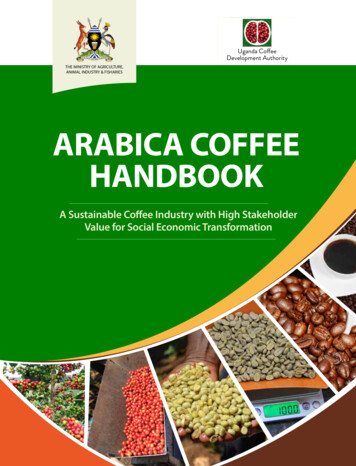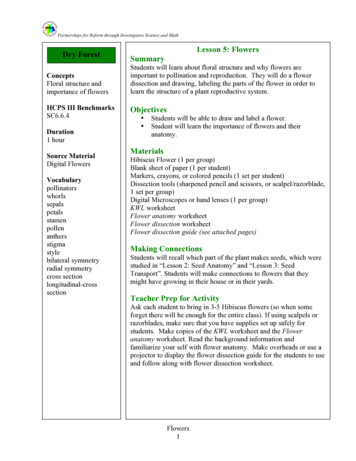
Transcription
AAASPlant PhenomicsVolume 2020, Article ID 6323965, 15 pageshttps://doi.org/10.34133/2020/6323965Research ArticleCoffee Flower Identification Using Binarization Algorithm Basedon Convolutional Neural Network for Digital ImagesPengliang Wei ,1 Ting Jiang ,1 Huaiyue Peng,1 Hongwei Jin,2 Han Sun,3 Dengfeng Chai,4,5and Jingfeng Huang 11Institute of Applied Remote Sensing and Information Technology, Zhejiang University, Hangzhou 310058, ChinaJiangsu Radio Scientific Institute Co., Ltd., Wuxi 214073, China3Innovation Institute of Disaster Prevention and Reduction at Inner Mongolia, Huhhot 010051, China4Institute of Spatial Information Technique, Zhejiang University, Hangzhou 310027, China5Electrical Engineering and Computer Science, University of California, Merced, CA 95343, USA2Correspondence should be addressed to Jingfeng Huang; hjf@zju.edu.cnReceived 13 May 2020; Accepted 30 August 2020; Published 6 October 2020Copyright 2020 Pengliang Wei et al. Exclusive Licensee Nanjing Agricultural University. Distributed under a Creative CommonsAttribution License (CC BY 4.0).Crop-type identification is one of the most significant applications of agricultural remote sensing, and it is important for yieldestimation prediction and field management. At present, crop identification using datasets from unmanned aerial vehicle (UAV)and satellite platforms have achieved state-of-the-art performances. However, accurate monitoring of small plants, such as thecoffee flower, cannot be achieved using datasets from these platforms. With the development of time-lapse image acquisitiontechnology based on ground-based remote sensing, a large number of small-scale plantation datasets with high spatial-temporalresolution are being generated, which can provide great opportunities for small target monitoring of a specific region. The maincontribution of this paper is to combine the binarization algorithm based on OTSU and the convolutional neural network(CNN) model to improve coffee flower identification accuracy using the time-lapse images (i.e., digital images). A certainnumber of positive and negative samples are selected from the original digital images for the network model training. Then, thepretrained network model is initialized using the VGGNet and trained using the constructed training datasets. Based on thewell-trained CNN model, the coffee flower is initially extracted, and its boundary information can be further optimized by usingthe extracted coffee flower result of the binarization algorithm. Based on the digital images with different depression angles andillumination conditions, the performance of the proposed method is investigated by comparison of the performances of supportvector machine (SVM) and CNN model. Hence, the experimental results show that the proposed method has the ability toimprove coffee flower classification accuracy. The results of the image with a 52.5 angle of depression under soft lightingconditions are the highest, and the corresponding Dice (F1) and intersection over union (IoU) have reached 0.80 and 0.67,respectively.1. IntroductionCoffee is one of the top three major beverages worldwide andhas important economic value. Coffea arabica L. is native toAfrica and cultivated in several provinces in China, especiallyin Yunnan Province. Early coffee flower monitoring is ofparamount importance in flowering regulation, irrigation,yield prediction, and other crop management tasks [1, 2];therefore, the accurate identification of coffee flowers is thekey to better managing these tasks. Nowadays, based onvarious data platforms, a number of datasets have beengenerated and developed for crop-type identification [3–8].Generally, for different identification fields, the datasets canbe divided into two main categories: datasets that are basedon manual observation [9, 10] and datasets that are basedon satellite platform observation [11–13]. However, as thedemand for observation grows, there are several disadvantages for plant identification in small-scale plantations usingthese types of datasets, which are explained as follows.While traditional manual observation is conducted bymeteorologists on a regular basis [14], because of the limitation of subjectivity and the number of personnel, it is difficultto achieve objective and continuous observation for manyyears. Consequently, the traditional manual observations
2are mainly applied to small and medium scope and shortterm observations. For instance, Ohashi et al. [9] studiedthe relationship between cherry blossom and climate, andin the process of cherry blossom identification, the floweringobservation dates were quite fixed and only for a specificnumber of cherry trees; thus, it was difficult to efficientlyobtain precise data. In addition, there have been manycrowdsourcing projects that use manual observation in plantphenology monitoring, such as observation of apple flowering in Germany [6], cherry blossom flowering period inJapan [10], the Project BudBurst in the United States [15],and so on [16]. However, it is difficult to measure the humancost in these methods, and there are subjective limitationsand data irregularities in the traditional manual observation,which cause difficultly in applying this type of data into lowdensity and high altitude areas.Compared with manual observation, it is more convenientto obtain datasets from satellite platforms, and the datasets canbe used to conduct continuous observation at different scalesfor many years [17, 18]. Remote sensing technologies basedon satellite platforms have been well developed for vegetationobservation [19–22], and they also have been applied to coffeephenology observation. For instance, MODIS datasets withhigh temporal resolution and coarse spatial resolution havebeen applied to observe coffee plantations in Brazil, whichwere aimed at predicting the distribution of coffee plants andobserving their phenology characteristics [23]. Similarly,Couto et al. [24] used the MODIS data to extract the timeseries change of the normalized vegetation index andenhanced vegetation index, which could be used to analyzethe differences between coffee and other land covers. However,it is difficult to achieve high spatial and temporal resolutionsimultaneously in such experiments, since the satelliteplatform is mostly based on large scale. Moreover, the precisepositioning of small targets (i.e., coffee flowers) cannot beachieved because of the coarser resolution of data from satellite platforms. In recent years, the applications of unmannedaerial vehicles (UAVs) have been well expanded to agriculture,and they have already been used for small-scale observation[2]; the possibilities of continuous and long-term observationare limited, since the technical cost and the cost of labor of asingle UAV flight are also high.Some achievements have been made by using the abovedatasets; however, accurate small target monitoring stillcannot be achieved in space and time. Consequently, in orderto obtain the distribution of small targets in small-scale plantations, and provide a reliable theoretical basis for real-timemonitoring, the use of high spatial-temporal resolutionimaging is necessary. Fortunately, with the development ofnear-ground remote sensing technology, the emergence oftime-lapse images that have high spatial-temporal resolutionhas effectively solved the problem of small target recognitionand achieved the vegetation development monitoring in nearreal time for specific areas [25–31]. For instance, Zhang et al.[32] monitored crop growth using time-lapse images andcalculated nine color vegetation indices from the acquiredtime series digital photographs to arrive at a fractional vegetation cover estimation model for different crops. Tan et al.[33] used simple linear iterative clustering (SLIC) for wheatPlant Phenomicsspike identification in digital images based on the super greenvalue and normalized red green index. Moreover, Peng et al.[34] have already proposed an SVM model based on superpixel merging (i.e., SPMG) to identify coffee flowers usingdigital images. Consequently, time-lapse images with highspatial-temporal resolution will play an increasingly important role in providing accurate and continuous data for smalltarget monitoring.Although a time-lapse image can play a better role insmall-scale observation, its recognition accuracy needs to befurther improved. The main reason it has low recognitionaccuracy is that the identification is based on traditionalalgorithms that only consider pixel-level features and ignorethe space characteristics. With the development of computervision technology, deep learning has attracted more andmore attention in the field of image recognition, due to itsability to extract multiscale features, and it has been wellmigrated to the application of time-lapse image identification[35–37]. For instance, Xiong et al. [38] combined the SLICand convolutional neural network (CNN) to identify ricepanicles in digital images. Desai et al. [39] used CNN todetect regions containing flowering panicles from digitalimages of paddy rice, which can be used to estimate the heading date of the crop. However, for the traditional CNNmodels, in order to achieve image segmentation, a localregion (patch) around a pixel, which is generated by using asliding window, is selected to be the input of the CNN modelto acquire the label of the center pixel of the patch. Mainlybecause of the existence of nontarget objects in the patch,the boundary of the target will be overrecognized in the finalsegmentation result, which is especially true in the case ofsmall targets.Therefore, in order to further improve coffee floweridentification accuracy, based on time-lapse images, this paperutilizes the binarization algorithm and deep learning model tocombine the pixel-level and space characteristics to discriminate coffee flowers from a complex background, and imageswith different depression angles and illumination conditionsare identified using different models to validate the advantagesof the combination of the binarization algorithm and deeplearning model.2. Materials and Methods2.1. Study Area and Image Acquisition. The experimentalfield is a coffee plantation located in Lujiangba District ofBaoshan, Yunnan Province, China. The annual averagetemperature is 21.3 C, the absolute maximum temperatureis 40.4 C, and the absolute minimum temperature is 0.2 C.The climate of this area is categorized as a subtropical dryhot valley. The anthesis of the coffee in the study area occursfrom March to May. The images used in the experiment weretaken by an automatic observation device under naturalillumination conditions. The device is mounted at an altitudeof 5.8 m above ground level (Figure S1 (a)). A CCD imagesensor is adapted by the camera, and its pan-and-tilt headcloud platform can be set to 24 different shooting angles,composed of 3 depression angles (i.e., 27.5 , 52.5 , and77.5 ) and 8 azimuth angles (i.e., 45 apart) (Figure S1 (b)).
Plant PhenomicsThe resolution of the device is two million pixels, and thesize of images acquired from the device is 1920 ðlengthÞ 1080 ðwidthÞ pixels. The acquired digital images were shotat 08:00, 09:00, 10:00, 11:00, 12:00, 13:00, 14:00, 15:00,16:00, 17:00, and 17:30 every day from March 1st to May31st in 2017, during which five flowering events wereobserved (Figure 1).In order to quantitatively analyze the identificationaccuracy of coffee flowers, the methods based on superpixelsegmentation and visual interpretation are combined to buildthe ground truth map, the superpixel that contains the coffeeflower is set to 1, and the background is set to 0. Then, theground truth maps, under different illumination conditionsand shooting depression angles, can be produced (Figure 2).2.2. The Binarization Algorithm Based on CNN. CNN hasbeen well applied to the field of image recognition. Generally,the structures of the CNN model mainly include the convolution layer, pooling layer, and full connection layer. Thenumber of network parameters is reduced through weightsharing, which can improve the efficiency of the network.The pooling layer can ensure the invariance of displacement,scaling, and distortion while the feature dimension is reduced.For the setting of the network structure, the convolution layerand pooling layer are usually crossconfigured, and activationlayers are set after each hidden layer (including the convolution layer and full connection layer) to achieve nonlineartransformation and accelerate the convergence speed of thenetwork. Therefore, an arbitrarily complex CNN structurecan be designed through different ways of configuring theconvolution, pooling, and activation layers. However, there isstill no effective theoretical guidance on how to design aCNN network so that it can meet the performance requirements. Experiments and even empirical intuition are stilleffective methods by which to design a CNN network withhigh performance. Currently, the LeNet [40], AlexNet [41],VGGNet [42], and GoogLeNet [43] are typical structures ofa CNN model. Among them, VGGNet is a deep CNN networkcomposed of multiple convolution layers with the size of 3 3.Moreover, the advantages of this network have been verified inthe classification task of ImageNet, and there are many classification and detection networks that have been designed basedon the structure of VGGNet [44, 45].Consequently, VGGNet is selected as the basic networkstructure for coffee flower identification. Details of thespecific network structure are located in [42]. The maindifference is that there are only two channels in the last fullyconnected layer, since coffee flower identification is a twocategory classification problem (Table 1). Each convolutionlayer is followed by a ReLU layer to speed up the networkconvergence. Starting from the input image, the features flowdownwards through the left and right layers and finally reachthe output layer (Table 1).Through visual interpretation, it can be found that thereare noticeable color differences between the coffee flower(white) and the surrounding background (Figure 3(a)),which means that an optimal threshold can be found to maximize the variance between the two classes to achieve therough extraction of coffee flowers. Therefore, the binary3transformation based on OTSU [46] is used to extract thecontour information of the coffee flowers in the originalimage; from the segmentation result, it can be seen that theoutlines of the coffee flowers can be effectively extracted bythe binarization algorithm (i.e., OTSU) (Figure 3(b)).However, some background noise, which is relativelyclose to the pixel value of coffee flowers, has also beenextracted and misclassified as coffee flowers, since the OTSUalgorithm is a color-based threshold method. Moreover,there is a striking difference in the spatial informationbetween the background and the coffee flower, and the difference can be extracted by CNN and used to improve this kindof misclassification that remains in the binarization result. Inorder to illustrate that the background information close tothe color of the coffee flower can be suppressed by theCNN model, a brighter background image is classified, andthe features extracted by the third convolution layer are visualized (Figure 4). It can be found from the visualization resultthat there are some solid color images in the extractedfeatures, due to the highly consistent spatial features in theimage block (i.e., all of the pixels in the image block are background information). At the same time, there are also somegrayscale images similar to the original image, because ofthe influence caused by the different color information ofthe background in the image block. Consequently, both colorand spatial information of the image block that correspond tothe background can be learned by the trained CNN, which isthe reason that the VGGNet can effectively suppress theexcessive misclassification caused by the color value-basedthreshold method. However, there will be some redundantinformation for the coffee flower boundary in the pathbased CNN results, mainly because the entire image blockwill be classified into the same category.Therefore, in order to optimize coffee flower recognitionaccuracy, only the redundant background information thatremains in the binarization result is removed using theresults of path-based CNN, and the coffee flower informationextracted by the binarization is still retained. The specificsteps are described as follows:Step 1 (extraction of training datasets). A certain number ofpositive samples (i.e., coffee flowers) from the images withcoffee flowers and negative samples (i.e., background) fromthe images without coffee flowers are extracted according tothe specified neighborhood window size.Step 2 (training of CNN model). The initialized networkmodel is trained using the extracted positive and negativesamples.Step 3 (prediction). In forecasting the image comprised ofprediction sets, the whole image is predicted using a slidingwindow based on the trained CNN model, so as to achievethe initial recognition of coffee flower and backgroundinformation, and then the identification results are saved.Step 4 (extraction of boundary information). The binarization algorithm based on OTSU is used to find an optimalthreshold to maximize the variance between the coffee flower
4Plant Phenomics(a)(b)(c)(d)(e)Figure 1: The five flowering events. (a–e) represent the images acquired on March 7th, March 25th, April 11th, April 27th, and May 25th, 2017,respectively.Only coffeeflowers areretained by visualinterpretationResult of superpixel oversegmentationGround truthFigure 2: The process of generating ground truth.and the background, which can effectively separate theboundary contour information of the coffee flower from thebackground.Step 5 (correction of boundary information). Finally, theboundary information of the coffee flowers acquired fromStep 4 is used to limit the contour range of coffee flowersidentified by Step 3, so as to achieve the optimization purposeof the patch-based CNN model. In other words, the result ofthe patch-based CNN model is used to remove the background information left in the binarization result.Therefore, the CNN model and binarization algorithmare combined (Bin CNN) to further optimize the coffeeflower identification results.In order to validate the advantages of the proposedmethod (i.e., Bin CNN), the coffee flower identificationresults based on the method presented in [34] (i.e., SPMG),CNN, and Bin CNN models are compared (Figure 5).2.3. Selection of the Training Datasets. The training samples,composed of positives (flower regions) and negatives(background regions), are selected from multiscale regionsof images. Forty images are used to select positive samples,
Plant Phenomics5Table 1: The specific setting of the network structure.InputOutputConv3 3 3 64Conv3 3 64 64FC-2MaxPoolingConv3 3 64 128FC-4096Conv3 3 128 128MaxPoolingFC-4096MaxPoolingConv3 3 512 512Conv3 3 128 256Conv3 3 512 512Conv3 3 256 256Conv3 3 512 512Conv3 3 256 256MaxPoolingMaxPoolingConv3 3 256 512Conv3 3 512 512Conv3 3 512 512which were taken from 5 different flowering times, 11 shooting hours, and 9 different angles (i.e., 3 depression angles and3 azimuth angles). Twelve images, which were taken fromfive flowering dates without flower images, are used to selectnegative samples.For the training datasets of the SVM model based onsuperpixel merging, the image is first divided into 15,000superpixels by SLICO algorithm (i.e., SLIC zero) [47], andthen 1500 merged regions can be obtained for each image(Figure 6). By combining similar regions and removingduplicates, the final merged sample sets can be obtained(Figure 6(c)), and there are a total of 3087 unequal coffeeflower sample areas in all the images that contain coffeeflowers. The center coordinates of all of the merged regionsare recorded (i.e., red points in Figure 6(d)) to facilitate thepositive sample selection of the CNN model. For negativesamples, images without coffee flowers are selected. Comparedwith coffee flower information, the background information ismore complicated, which means that more background information needs to be selected as negative samples. In the sameway, superpixel segmentation and merging are carried out,respectively. One thousand five hundred merged regions wereobtained for each image, and the final number of the negativesample sets is 18,000.For the training datasets of the CNN model, the coordinates of coffee flowers, which are recorded in the above selection process, are used as the center of the neighborhood block(i.e., white point in Figure 7(a)). Therefore, the center point ofeach image block (i.e., positive sample of CNN) correspondsto the center of each merged superpixel (i.e., positive sampleof SVM) one by one. Mainly because the result extracted byCNN is used to remove the background information left inthe binarization result, the window size should cover thecomplete coffee flower. Otherwise, the boundary informationextracted by binarization will also be shrunk by CNN. Finally,the size of the image block is taken as 31 31, since the size ofthe coffee flower is about 900 pixels (Figure 7(b)). For negativesamples, 1500 neighborhood blocks are randomly selectedusing the same way for each image.2.4. CNN Training. The specific parameter settings ofnetwork training are described as follows. For the SPMGmodel, the relevant parameters and kernel function areselected according to reference [34]. For the CNN model, aminibatch random gradient descent method with momentum factor is used to train the network, the number of eachminibatch sample is set to 100, and the momentum factoris set to 0.9 [48], which is a fixed value. The weights of allof the layers are initialized using a Gaussian distribution witha mean of 0 and a standard deviation of 0.01 [42]. The biasesof all of the convolutional layers and fully connected layersare initialized to 0. The initial learning rate is set to 0.01.When the accuracy error rate of the verification set is gradually stable during the training process, the training speed isslowed down by changing the learning rate to 10% of thecurrent learning rate until the maximum training step isreached (i.e., 100). The specific process of the training lossis recorded (Figure 8). For the Bin CNN model, the corresponding parameters of the network are set in the same way.The modeling process is performed on a Windows workstation (Windows 10) with an Intel Xeon Gold 5218 Processor (16-core, 16M cache), 128 GB of RAM, and an NVIDIAQuadro P4000 graphics card (8 GB of RAM). Both of thedeep learning models are implemented on the MATLABplatform using the MatConvNet library.2.5. Assessment of the Identification Accuracy. In this study,the model performance is evaluated by comparing the recall,precision, Dice (F1), and the intersection over union (IoU),and the last two parameters are indicators that comprehensively consider recall and precision [34]. The correspondingparameters can be calculated usingRecall TP,TP FNPrecision F1 IoU 2 Rseg RgtRseg RgtRseg RgtRseg RgtTP,TP FP 2TP,2TP FP FNTP,TP FP FNð1Þð2Þð3Þð4Þwhere TP is the true positive, FP is the false positive, FN is thefalse negative, TN is the true negative, Rseg is the results ofidentification, and Rgt is the ground truth.3. ResultsThe coffee flower images with different depression angles andillumination conditions are identified by SPMG, CNN, andBin CNN models, and the corresponding coffee flower identification results are compared to validate advantages of theproposed method (i.e., the Bin CNN model).3.1. Comparison Based on Different Methods for TrainingDatasets. One of the training images is selected to validate
6Plant Phenomics(a)(b)Figure 3: Binarization processing: (a) original image; (b) results of the binarization.the trained SVM and CNN models. From the specific identification results (Figure 9(a), Figure S2, and Table 2), it can beseen that the recall rate of the CNN model reached 0.93,which is the highest compared to the other methods.However, there is too much false identification because theboundary information is amplified, which makes its otherevaluation parameters low. For the results of the SPMGmodel, conversely, there is much more missingidentification, since the spatial characteristics are ignored.For the results of the Bin CNN model, as we expected, itcan effectively correct the boundaries of the coffee flowersextracted by the CNN model, and the corresponding
Plant Phenomics7Original dataFigure 4: The extracted features of the background. The first image is the original input data; others are the extracted features from the thirdset of convolutional layers.Original imagesused for trainingSuperpixel oversegmentationfor all imagesExtracting thetraining data setsSuperpixel merging toobtain multiscale regionsTraining the CNNmodelSelecting the trainingsamplesOriginal imagesused for predictionExtracting the color andtexture featuresBinarizationprocessingThe trained CNNmodelTraining the SVM modelPredicting the processed imagesbased on the trained SVM modelThe background left in the results of binarizationis removed using the results of CNNIdentification resultsof SPMG modelIdentification resultsof bin CNN modelsIdentification resultsof CNN modelComparing theidentification resultsFigure 5: The flow chart of the research.evaluation parameters have been clearly improved comparedto those of the CNN models, and its recall, F1, and IoU are0.16, 0.03, and 0.04 higher than those of the SPMG model,respectively.images with different depression angles (i.e., 27.5 , 52.5 ,and 77.5 ) and illumination conditions (i.e., soft and intenselighting conditions) are identified using different methods,and the corresponding results are analyzed as follows.3.2. Comparison Based on Different Methods and DepressionAngles for Test Datasets. In order to further validate therobustness and advantages of the proposed method, the test3.2.1. Results of the Image with a 27.5 Angle of Depression.The coffee flower image with a 27.5 angle of depressionunder soft lighting conditions is identified using the SPMG,
8Plant Phenomics(a)(b)(c)(d)Figure 6: Generation of multiscale regions: (a) original image, (b) superpixel oversegmentation, (c) superpixel merging, and (d) the mergedsample sets and coordinate point of the corresponding sample.CNN, and Bin CNN models (Figure 9(b), Figure S3, andTable 3).From the identification results, it can be seen that coffeeflowers cannot be clearly displayed in the image with a27.5 angle of depression, which makes it more difficult torecognize distribution information of coffee flowers. For theresults of the SPMG model, the coffee flowers are hardlyrecognized, and all of the evaluation parameters are low.For the results of the CNN model, its recall rate reached0.75, which is much better than that of the SPMG model.However, there is still some overidentification, leading tolow precision, F1, and IoU. For the results of the Bin CNNmodel, its recall rate is similar to that of the CNN model,and mainly because the overidentification of coffee flower iseffectively reduced, the corresponding evaluation parameters(i.e., precision, F1, and IoU) are improved by 0.1, 0.11, and0.08 compared with those of the CNN model, respectively.Therefore, for the small depression angle, the proposedmethod can improve the identification results of the coffeeflower compared with the SPMG and CNN models.3.2.2. Results of the Image with a 52.5 Angle of Depression.The observed depression angle is increased to 52.5 , sincethe coffee flowers were not observed well under the 27.5 angle of depression. Therefore, the coffee flower image witha 52.5 angle of depression under soft lighting conditions isidentified using the SPMG, CNN, and Bin CNN models(Figure 9(c), Figure S4, and Table 4).
Plant 744137537637737817452174531745417455(b)Figure 7: The input of the CNN model: (a) example of the input data based on the CNN model (i.e., the red image block with a size of 31 31 3); (b) parts of the positive and negative training samples.ObjectiveTop 1 (b)Figure 8: The training process of the CNN model: (a) the loss of all samples in a batch; (b) the loss of misidentification samples in a batch.For the results of the SPMG model, the coffee flowers stillcannot be well identified, and the corresponding recall rateand IoU are only 0.46 and 0.40, respectively. For the resultsof the CNN model, its recall rate reached 0.91, which is muchbetter than that of the SPMG model. However, the corresponding precision is only 0.45, mainly because the boundary
10Plant PhenomicsCoffee FlowerBackground(a)Coffee FlowerBackground(b)Coffee FlowerBackground(c)Coffee FlowerBackground(d)Figure 9: Continued.
Plant Phenomics11Coffee FlowerBackground(e)Coffee FlowerBackground(f)Figure 9: Coffee flower identification results of the Bin CNN for different datasets. (a) Result of training data sets. (b–d) are the results ofimages with depression angles of 27.5 , 52.5 , and 77.5 under soft lighting conditions, respectively. (e, f) are the results of images withdepression angles of 27.5 and 52.5 under intense lighting conditions, respectively. In addition, the first, middle, and third columns are theoriginal images, ground truth maps, and identification results of the Bin CNN, respectively.Table 2: Evaluation parameters of the training image.SPMGCNNBin 70.580.800.630.410.67Table 3: Evaluation parameters of image with a 27.5 angle ofdepression.SPMGCNNBin 70.280.390.160.160.24Table 4: Evaluation parameters of image with a 52.5 angle ofdepression.SPMGCNNBin 60.600.800.400.430.67information of the coffee flower is enlarged. For the results ofthe Bin CNN model, there is a clear advantage compare
pretrained network model is initialized using the VGGNet and trained using the constructed training datasets. Based on the well-trained CNN model, the coffee flower is initially extracted, and its boundary information can be further optimized by using the extracted coffee flower result of the binarization algorithm.

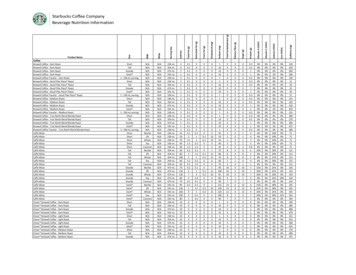
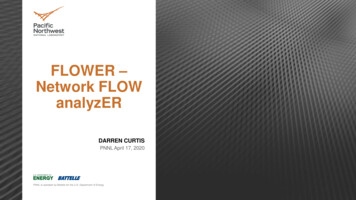
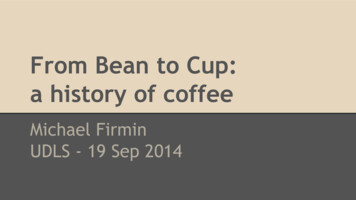
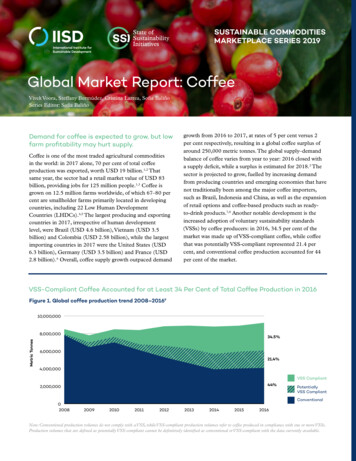


![[Ringle Material] 3rd wave coffee (Philz Coffee and Blue .](/img/22/2592b1ca.jpg)
